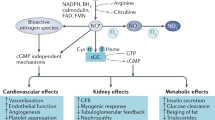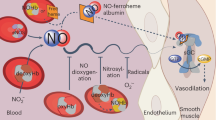Abstract
Nitrite represents a bioactive reservoir of nitric oxide (NO) that may modulate vasodilation, respiration and cytoprotection after ischemia-reperfusion injury. Although nitrite formation is thought to occur via reaction of NO with oxygen, this third-order reaction cannot compete kinetically with the reaction of NO with hemoglobin to form nitrate. Indeed, the formation of nitrite from NO in the blood is limited when plasma is substituted with physiological buffers, which suggests that plasma contains metal-based enzymatic pathways for nitrite synthesis. We therefore hypothesized that the multicopper oxidase, ceruloplasmin, could oxidize NO to NO+, with subsequent hydration to nitrite. Accordingly, plasma NO oxidase activity was decreased after ceruloplasmin immunodepletion, in ceruloplasmin knockout mice and in people with congenital aceruloplasminemia. Compared to controls, plasma nitrite concentrations were substantially reduced in ceruloplasmin knockout mice, which were more susceptible to liver infarction after ischemia and reperfusion. The extent of hepatocellular infarction normalized after nitrite repletion. These data suggest new functions for the multicopper oxidases in endocrine NO homeostasis and nitrite synthesis, and they support the hypothesis that physiological concentrations of nitrite contribute to hypoxic signaling and cytoprotection.
This is a preview of subscription content, access via your institution
Access options
Subscribe to this journal
Receive 12 print issues and online access
$259.00 per year
only $21.58 per issue
Buy this article
- Purchase on Springer Link
- Instant access to full article PDF
Prices may be subject to local taxes which are calculated during checkout






Similar content being viewed by others
References
Bryan, N.S. et al. Nitrite is a signaling molecule and regulator of gene expression in mammalian tissues. Nat. Chem. Biol. 1, 290–297 (2005).
Cosby, K. et al. Nitrite reduction to nitric oxide by deoxyhemoglobin vasodilates the human circulation. Nat. Med. 9, 1498–1505 (2003).
Crawford, J.H. et al. Hypoxia, red blood cells, and nitrite regulate NO-dependent hypoxic vasodilation. Blood 107, 566–574 (2006).
Gladwin, M.T. et al. The emerging biology of the nitrite anion. Nat. Chem. Biol. 1, 308–314 (2005).
Lundberg, J.O. & Weitzberg, E. NO generation from nitrite and its role in vascular control. Arterioscler. Thromb. Vasc. Biol. 25, 915–922 (2005).
Li, H., Samouilov, A., Liu, X. & Zweier, J.L. Characterization of the magnitude and kinetics of xanthine oxidase-catalyzed nitrite reduction. Evaluation of its role in nitric oxide generation in anoxic tissues. J. Biol. Chem. 276, 24482–24489 (2001).
Modin, A. et al. Nitrite-derived nitric oxide: a possible mediator of 'acidic-metabolic' vasodilation. Acta Physiol. Scand. 171, 9–16 (2001).
Zweier, J.L., Wang, P., Samouilov, A. & Kuppusamy, P. Enzyme-independent formation of nitric oxide in biological tissues. Nat. Med. 1, 804–809 (1995).
Nagababu, E., Ramasamy, S., Abernethy, D.R. & Rifkind, J.M. Active nitric oxide produced in the red cell under hypoxic conditions by deoxyhemoglobin-mediated nitrite reduction. J. Biol. Chem. 278, 46349–46356 (2003).
Duranski, M.R. et al. Cytoprotective effects of nitrite during in vivo ischemia-reperfusion of the heart and liver. J. Clin. Invest. 115, 1232–1240 (2005).
Webb, A. et al. Reduction of nitrite to nitric oxide during ischemia protects against myocardial ischemia-reperfusion damage. Proc. Natl. Acad. Sci. USA 101, 13683–13688 (2004).
O'Donnell, V.B. et al. Nitration of unsaturated fatty acids by nitric oxide-derived reactive nitrogen species peroxynitrite, nitrous acid, nitrogen dioxide, and nitronium ion. Chem. Res. Toxicol. 12, 83–92 (1999).
Hazen, S.L. et al. Formation of nitric oxide-derived oxidants by myeloperoxidase in monocytes: pathways for monocyte-mediated protein nitration and lipid peroxidation in vivo. Circ. Res. 85, 950–958 (1999).
Bryan, N.S. et al. Cellular targets and mechanisms of nitros(yl)ation: an insight into their nature and kinetics in vivo. Proc. Natl. Acad. Sci. USA 101, 4308–4313 (2004).
Huang, K.T. et al. The reaction between nitrite and deoxyhemoglobin. Reassessment of reaction kinetics and stoichiometry. J. Biol. Chem. 280, 31126–31131 (2005).
Huang, Z. et al. Enzymatic function of hemoglobin as a nitrite reductase that produces NO under allosteric control. J. Clin. Invest. 115, 2099–2107 (2005).
Dejam, A. et al. Erythrocytes are the major intravascular storage sites of nitrite in human blood. Blood 106, 734–739 (2005).
Kleinbongard, P. et al. Plasma nitrite reflects constitutive nitric oxide synthase activity in mammals. Free Radic. Biol. Med. 35, 790–796 (2003).
Kim-Shapiro, D.B., Schechter, A.N. & Gladwin, M.T. Unraveling the reactions of nitric oxide, nitrite, and hemoglobin in physiology and therapeutics. Arterioscler. Thromb. Vasc. Biol. 26, 697–705 (2006).
Ford, P.C., Wink, D.A. & Stanbury, D.M. Autoxidation kinetics of aqueous nitric oxide. FEBS Lett. 326, 1–3 (1993).
Wang, X. et al. Biological activity of nitric oxide in the plasmatic compartment. Proc. Natl. Acad. Sci. USA 101, 11477–11482 (2004).
Lauer, T. et al. Direct biochemical evidence for eNOS stimulation by bradykinin in the human forearm vasculature. Basic Res. Cardiol. 98, 84–89 (2003).
Zhang, Y. & Hogg, N. Mixing artifacts from the bolus addition of nitric oxide to oxymyoglobin: implications for S-nitrosothiol formation. Free Radic. Biol. Med. 32, 1212–1219 (2002).
Rafikova, O., Rafikov, R. & Nudler, E. Catalysis of S-nitrosothiols formation by serum albumin: the mechanism and implication in vascular control. Proc. Natl. Acad. Sci. USA 99, 5913–5918 (2002).
Hellman, N.E. & Gitlin, J.D. Ceruloplasmin metabolism and function. Annu. Rev. Nutr. 22, 439–458 (2002).
Musci, G., Polticelli, F. & Calabrese, L. Structure/function relationships in ceruloplasmin. Adv. Exp. Med. Biol. 448, 175–182 (1999).
Harris, Z.L. et al. Aceruloplasminemia: molecular characterization of this disorder of iron metabolism. Proc. Natl. Acad. Sci. USA 92, 2539–2543 (1995).
Sarkar, J., Seshadri, V., Tripoulas, N.A., Ketterer, M.E. & Fox, P.L. Role of ceruloplasmin in macrophage iron efflux during hypoxia. J. Biol. Chem. 278, 44018–44024 (2003).
Osaki, S., Johnson, D.A. & Frieden, E. The possible significance of the ferrous oxidase activity of ceruloplasmin in normal human serum. J. Biol. Chem. 241, 2746–2751 (1966).
Torres, J. & Wilson, M.T. The reactions of copper proteins with nitric oxide. Biochim. Biophys. Acta 1411, 310–322 (1999).
Inoue, K. et al. Nitrosothiol formation catalyzed by ceruloplasmin. Implication for cytoprotective mechanism in vivo. J. Biol. Chem. 274, 27069–27075 (1999).
Hughes, M.N. Relationships between nitric oxide, nitroxyl ion, nitrosonium cation and peroxynitrite. Biochim. Biophys. Acta 1411, 263–272 (1999).
Meyer, L.A., Durley, A.P., Prohaska, J.R. & Harris, Z.L. Copper transport and metabolism are normal in aceruloplasminemic mice. J. Biol. Chem. 276, 36857–36861 (2001).
Miyajima, H. Aceruloplasminemia, an iron metabolic disorder. Neuropathology 23, 345–350 (2003).
Harris, Z.L. Aceruloplasminemia. J. Neurol. Sci. 207, 108–109 (2003).
Xu, X., Pin, S., Gathinji, M., Fuchs, R. & Harris, Z.L. Aceruloplasminemia: an inherited neurodegenerative disease with impairment of iron homeostasis. Ann. NY Acad. Sci. 1012, 299–305 (2004).
Yoshida, K. et al. Increased lipid peroxidation in the brains of aceruloplasminemia patients. J. Neurol. Sci. 175, 91–95 (2000).
Harada, H. et al. Selected contribution: effects of gender on reduced-size liver ischemia and reperfusion injury. J. Appl. Physiol. 91, 2816–2822 (2001).
Fox, P.L., Mukhopadhyay, C. & Ehrenwald, E. Structure, oxidant activity, and cardiovascular mechanisms of human ceruloplasmin. Life Sci. 56, 1749–1758 (1995).
Gitlin, J.D. Transcriptional regulation of ceruloplasmin gene expression during inflammation. J. Biol. Chem. 263, 6281–6287 (1988).
Torres, J., Sharpe, M.A., Rosquist, A., Cooper, C.E. & Wilson, M.T. Cytochrome c oxidase rapidly metabolises nitric oxide to nitrite. FEBS Lett. 475, 263–266 (2000).
Martin, F. et al. Copper-dependent activation of hypoxia-inducible factor (HIF)-1: implications for ceruloplasmin regulation. Blood 105, 4613–4619 (2005).
Mukhopadhyay, C.K., Mazumder, B. & Fox, P.L. Role of hypoxia-inducible factor-1 in transcriptional activation of ceruloplasmin by iron deficiency. J. Biol. Chem. 275, 21048–21054 (2000).
Singh, T.K. Serum ceruloplasmin in acute myocardial infarction. Acta Cardiol. 47, 321–329 (1992).
Ehrenwald, E., Chisolm, G.M. & Fox, P.L. Intact human ceruloplasmin oxidatively modifies low density lipoprotein. J. Clin. Invest. 93, 1493–1501 (1994).
Fox, P.L., Mazumder, B., Ehrenwald, E. & Mukhopadhyay, C.K. Ceruloplasmin and cardiovascular disease. Free Radic. Biol. Med. 28, 1735–1744 (2000).
Miyajima, H., Takahashi, Y., Serizawa, M., Kaneko, E. & Gitlin, J.D. Increased plasma lipid peroxidation in patients with aceruloplasminemia. Free Radic. Biol. Med. 20, 757–760 (1996).
Miyajima, H. et al. Increased very long-chain fatty acids in erythrocyte membranes of patients with aceruloplasminemia. Neurology 50, 130–136 (1998).
Miyajima, H. et al. Increased oxysterols associated with iron accumulation in the brains and visceral organs of acaeruloplasminaemia patients. QJM 94, 417–422 (2001).
Yang, B.K., Vivas, E.X., Reiter, C.D. & Gladwin, M.T. Methodologies for the sensitive and specific measurement of S-nitrosothiols, iron-nitrosyls, and nitrite in biological samples. Free Radic. Res. 37, 1–10 (2003).
Lim, M.D., Lorkovic, I.M. & Ford, P.C. The preparation of anaerobic nitric oxide solutions for the study of heme model systems in aqueous and nonaqueous media: some consequences of NO x impurities. Methods Enzymol. 396, 3–17 (2005).
Sunderman, F.W., Jr & Nomoto, S. Measurement of human serum ceruloplasmin by its p-phenylenediamine oxidase activity. Clin. Chem. 16, 903–910 (1970).
Acknowledgements
We would like to thank D. Lefer and M. Duranski for generous instruction in the performance of the hepatic I/R protocol. We thank P. Fox for helpful discussions about ceruloplasmin.
Author information
Authors and Affiliations
Contributions
S.S., acquisition, analysis and interpretation of data, and drafting and revision of the manuscript; X.W., L.A.R., X.X., S.Y. and V.A., acquisition of data; H.M., supplying of critical samples; N.H., acquisition, analysis and interpretation of data; Z.L.H. and M.T.G., analysis and interpretation of data, and drafting and critical review of the manuscript.
Corresponding author
Ethics declarations
Competing interests
The authors declare no competing financial interests.
Rights and permissions
About this article
Cite this article
Shiva, S., Wang, X., Ringwood, L. et al. Ceruloplasmin is a NO oxidase and nitrite synthase that determines endocrine NO homeostasis. Nat Chem Biol 2, 486–493 (2006). https://doi.org/10.1038/nchembio813
Received:
Accepted:
Published:
Issue Date:
DOI: https://doi.org/10.1038/nchembio813
This article is cited by
-
Impact of microparticles released during murine systemic inflammation on macrophage activity and reactive nitrogen species regulation
Immunologic Research (2024)
-
PplD is a de-N-acetylase of the cell wall linkage unit of streptococcal rhamnopolysaccharides
Nature Communications (2022)
-
Migraine signaling pathways: amino acid metabolites that regulate migraine and predispose migraineurs to headache
Molecular and Cellular Biochemistry (2022)
-
Protective roles of inorganic nitrate in health and diseases
Current Medicine (2022)
-
Homocysteine and copper ions: is their interaction responsible for cardiovascular-related damage?
Amino Acids (2021)



